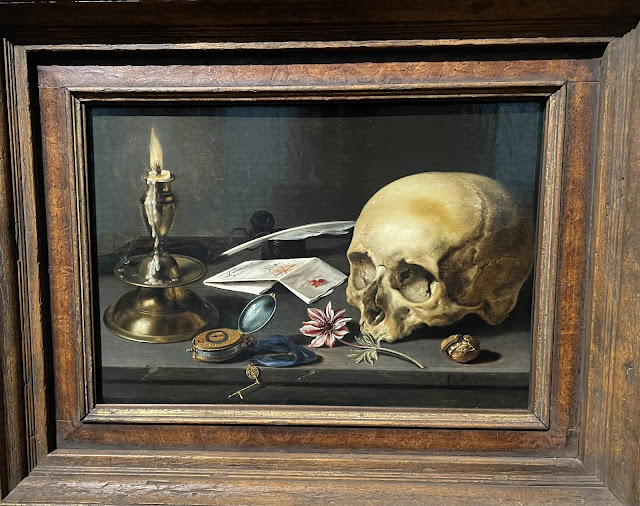 |
| Vanitas still life, by Pieter Glaesz (Franz Hals Museum, Haarlem, The Netherlands) |
A reader said that he went looking for documentary evidence of the 1999 Del Close wake mentioned in Sunday's post, and came up short. Another reason to regret that, unlike some papers, the Sun-Times does not have its archive online (though you can find it complete on NewsBank). I told him I'd post my story written about it at the time. Memory adds a few details. We had an entertainment editor, Darel Jevens, who adored comedy — he studied improv with Close — and would have plucked this story for himself. But there was some unavoidable scheduling problem, so he handed the plum assignment to me.
It was a challenge. The room was packed. My encounters with the stars were awkward. When I came face-to-face with Bill Murray — close enough to smell the booze on his breath — I blurted out something stupid, along the lines of, "So you trained under Del Close?" to which he twisted his face into an expression that eloquently conveyed, "I'm HERE, aren't I, idiot?"
Harold Ramis, the director of "Groundhog Day," had been featured in the paper that week, a piece by Dave Hoekstra. I observed that Dave seemed to do a good job — a safe intro — at which Ramis winced and exclaimed.
"He got something wrong!"
Oh no, I said, that isn't like Dave, what was the mistake?
"He referred to my 'Buddhist ATTACHMENT' and he meant 'Buddhist DETACHMENT."
"And you're displaying that now, big time," I thought, but did not say.
I wrote this immediately upon getting home, and it ran in the paper the next day, the day Close killed himself, which is why his death isn't mentioned.
Illinois Masonic Hospital was only a few blocks from where we lived on Pine Grove Avenue, and I remember walking home, thinking, "Wow. Some job I have."
With their friend and mentor on oxygen and battling for his life, Chicago comedy legends whose careers were shaped by Second City icon Del Close gathered in a basement room at Illinois Masonic Hospital Wednesday night for an unusual celebration that was half birthday party, half "pre-wake."
"I think he needs a little encouragement; I think that's all he needs," said film star Bill Murray. "Whatever he's going to do next, whatever his next project is."
About 50 people, including a pagan priest and priestess who performed a brief ceremony, feted the actor/director as he sat in a wheelchair while a film crew from Comedy Central taped the event.
Close, 64, a former drug addict and alcoholic, is suffering from complications due to emphysema.
"He was dying," said Charna Halpern, who co-founded the Improv Olympic theater with Close, adding that the event seemed to perk him up. "Del is a true comedian, a true performer who when faced with an audience comes back to life."
Students and professional associates came from as far away as Los Angeles to attend the party.
"I owe a lot to Del. He has been a major influence," said Randy Dixon, who owns the Market Theatre in Seattle.
"He is the dark and wonderful sinister influence on comedy over the last five or six decades," said Kelly Leonard, director of Second City. "Second City, `Saturday Night Live,' `SCTV' —anything great and funny and a little bit in bad taste is in part due to Del. He was an amazing teacher."
Messages of goodwill were read from people as varied as actor Peter Boyle and 1960s icon Wavy Gravy, who wrote, "See you in hell." Robin Williams called earlier.
Close was philosophical about his fate.
"The death of a working man at an American hospital doesn't have to be the traumatic agony that people think it is," he said.
Murray, who paid for the party, spent several minutes in serious conversation with his former Second City director. They spoke mostly of their salad days.
"You can have a pretty good life pretty cheap. I didn't know that until I was dying," Close said.
"I found it was better to live in New York when I had no money than when I had some money," said Murray, who asked Close if there was anything he could get him.
"That chocolate martini you were talking about," Close said.
"Del was, is, the single most powerful force in improv comedy in America," said writer and director Harold Ramis."He's the intellectual and moral standard that guides us all in our work. He taught everybody the process." — Originally published in the Sun-Times, March 4, 1999
.jpg)






